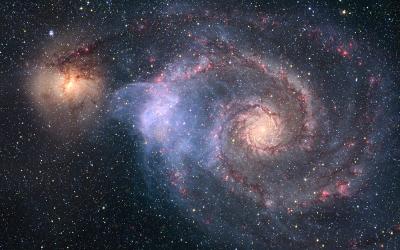OU research promises more precise pictures of space

Research by OU space academics to measure radiation’s impact on satellite telescopes promises to deliver more precise pictures of the Universe by making it easier to correct the damage protons cause to the images they capture.
The research will significantly help enhance the pictures beamed back to earth from the European Space Agency (ESA) and the Chinese Academy of Sciences' (CAS) 2024 joint Solar wind Magnetosphere Ionosphere Link Explorer (SMILE) mission to understand the dangers of space weather.
The Universe is full of high energy protons, hurtling through the vacuum of space. When these positively charged subatomic particles hit the Charged-Coupled Device (CCD) silicon image sensors used to photograph the Cosmos, they knock these sensitive imaging instruments' atoms out of place. These misaligned atoms disrupt the signal these devices transmit back to earth, resulting in smeared images.
While this damage is unavoidable, the OU researchers have measured its effects on CCD's performance on SMILE's soft X-ray imager (SXI) camera. First, the researchers replicated the imaging instruments' operating conditions in space by cooling SMILE CCDs to between minus 85 and minus 120 degrees Celsius in a cryogenic vacuum chamber. They then exposed them to the same radiation dose they would receive in orbit during the three-year mission in just 90 seconds. This process allowed them to predict how damage the devices are likely to sustain during the mission affects their performance. This data will be used to programme software to correct the images SMILE’s camera will send back to earth.
Published in the Journal of Instrumentation in November 2021, the research is the latest output from the Centre for Electronic Imaging (CEI), a collaboration between the OU and technology company Teledyne e2v. Since its formation in 2004, the CEI's growing community of more than 30 academics, researchers and PhD students has developed tailored image sensor technologies for 14 international European, US and Indian agency-led space missions.
Dr Steven Parsons led the research. He said:
"Accurate imaging is fundamental of space science. Without precise pictures of the Universe, we cannot accurately study space.
"These results give us a valuable insight into how the SMILE soft X-ray imager (SXI) camera will respond to the proton damage it will experience throughout the mission.
"With this knowledge, the images damaged devices send back to earth can be more easily corrected and ensure they are sufficiently accurate to offer meaningful data to support the scientific community to continue to unlock the secrets of the Universe."
Quarterly Review of Research
Read our Quarterly Review of Research to learn about our latest quality academic output.

Contact our news team
For all out of hours enquiries, please telephone +44 (0)7901 515891
